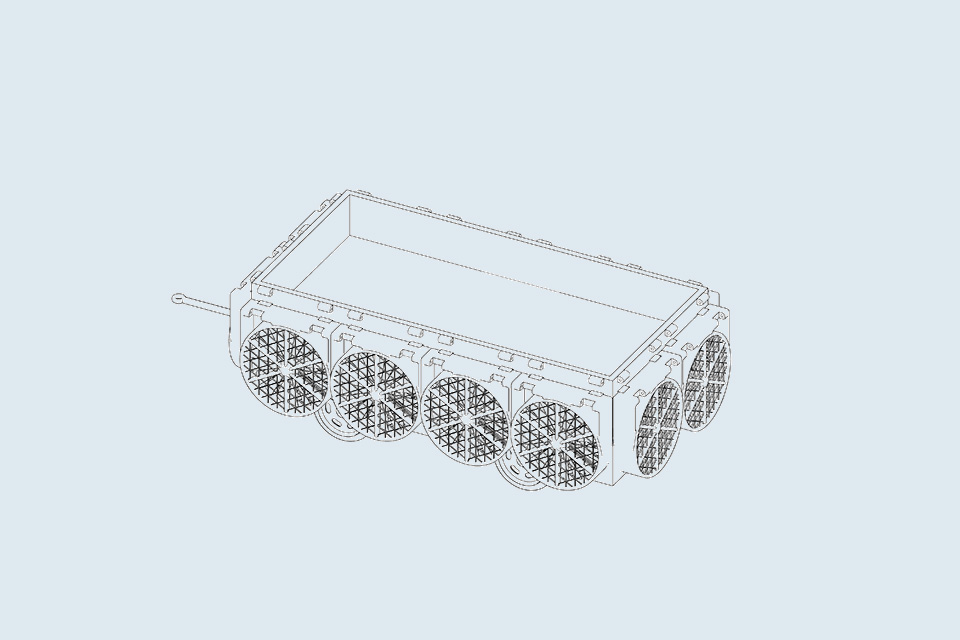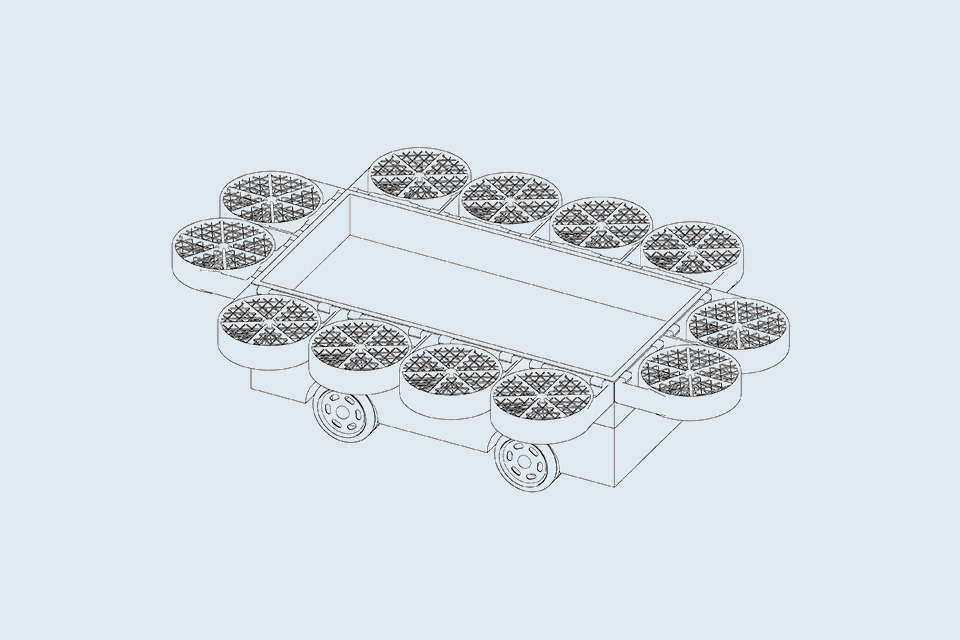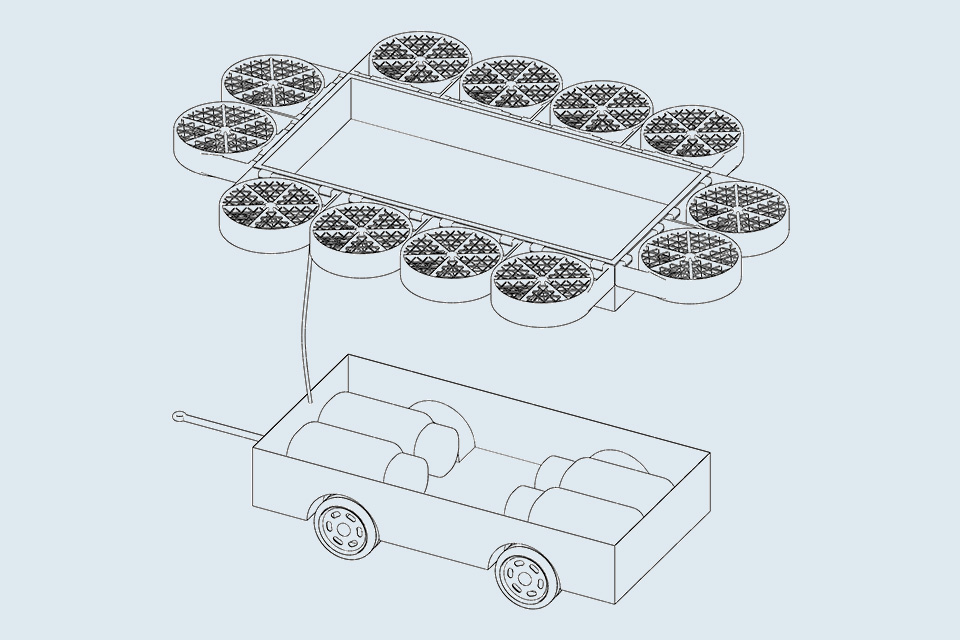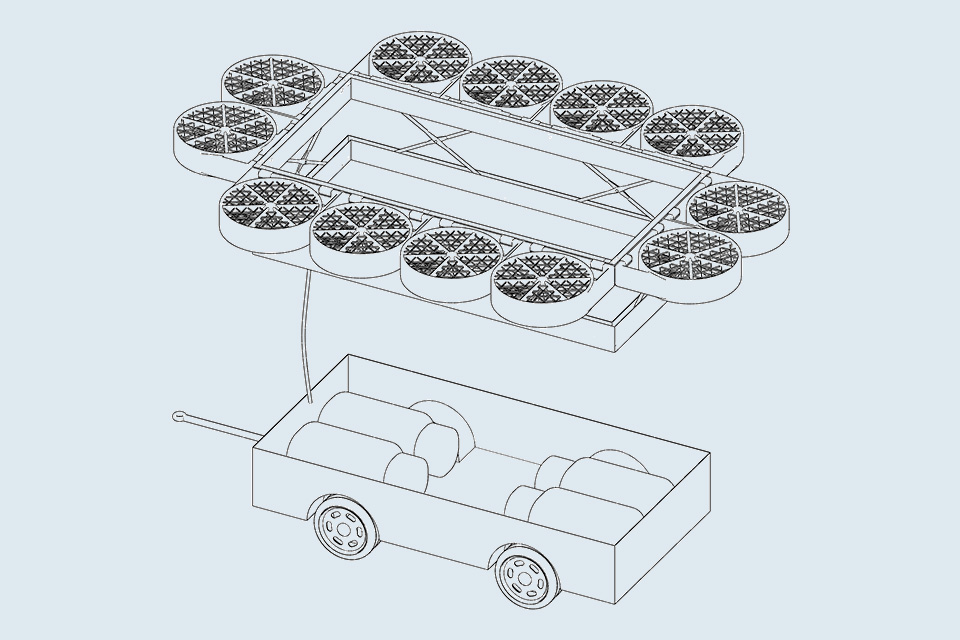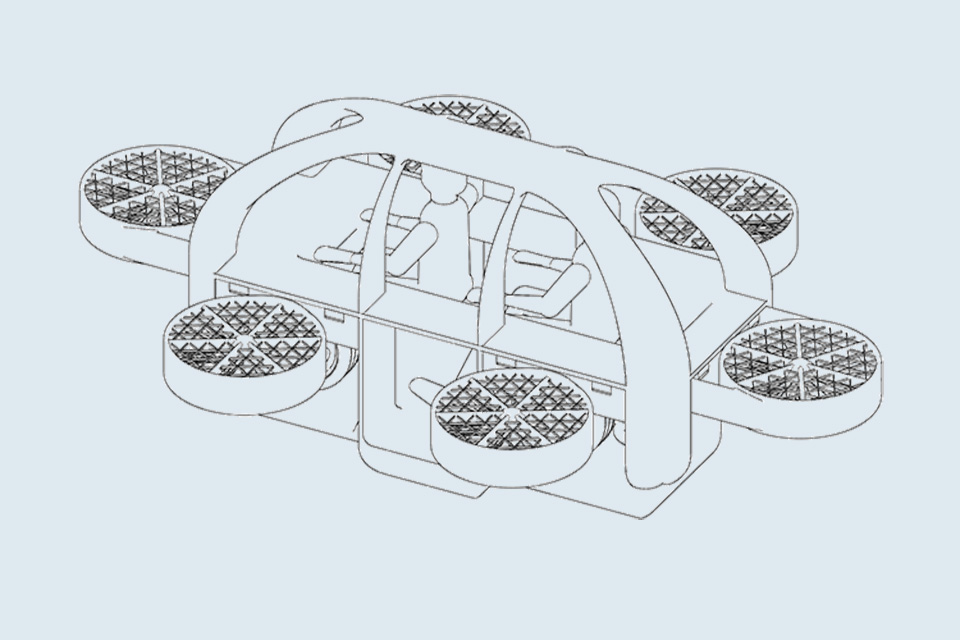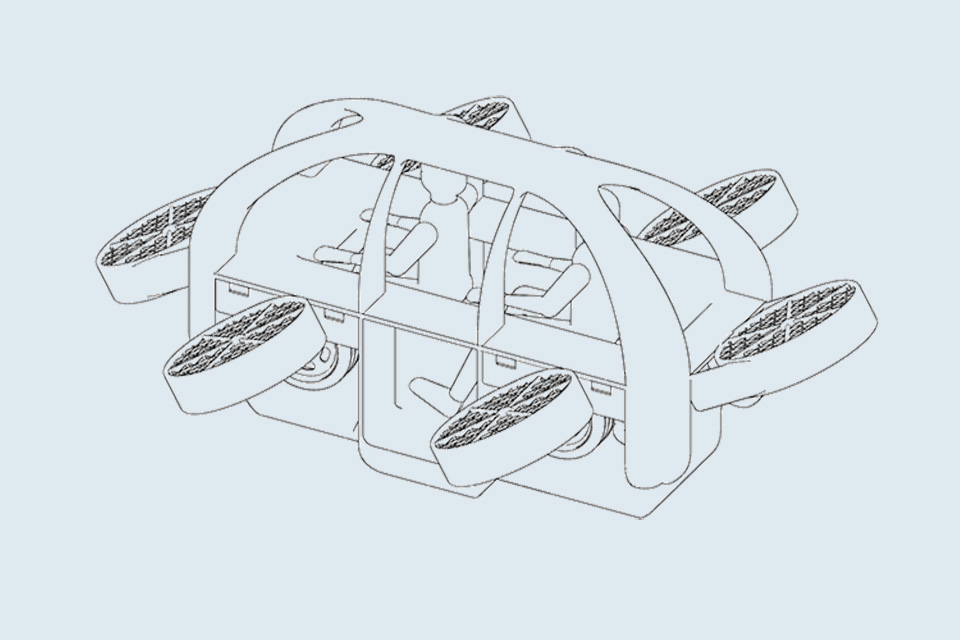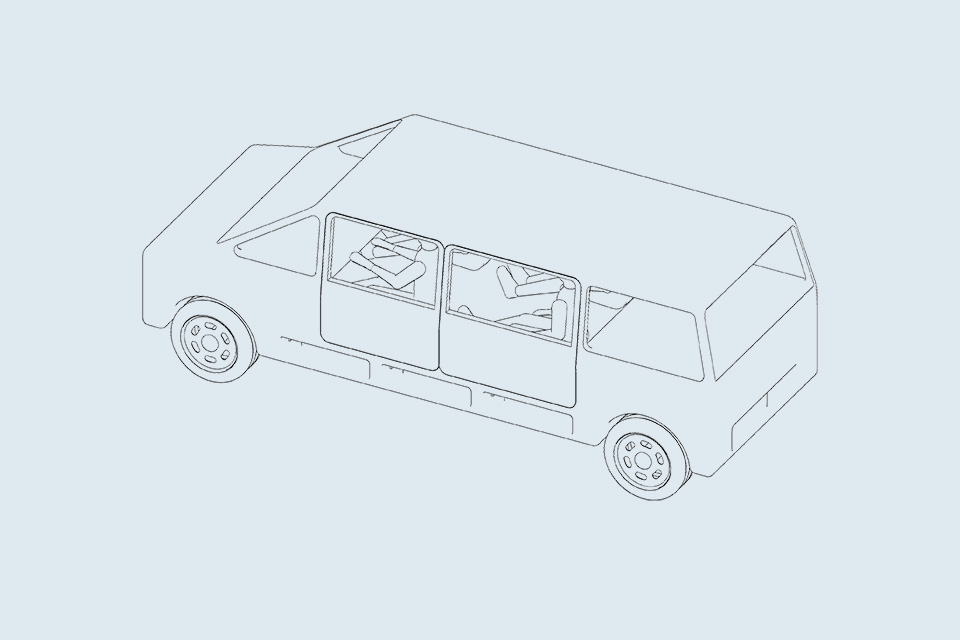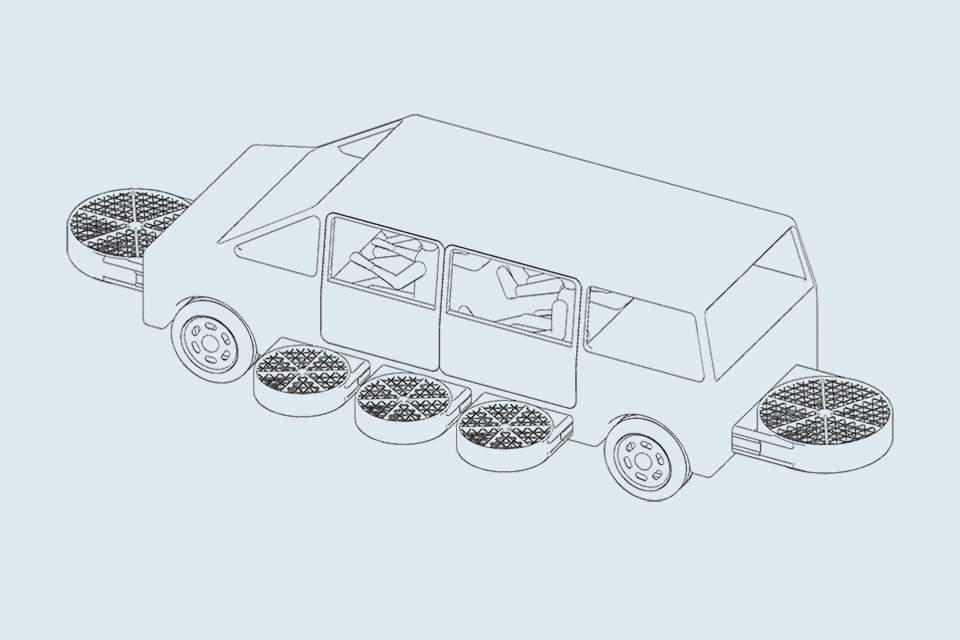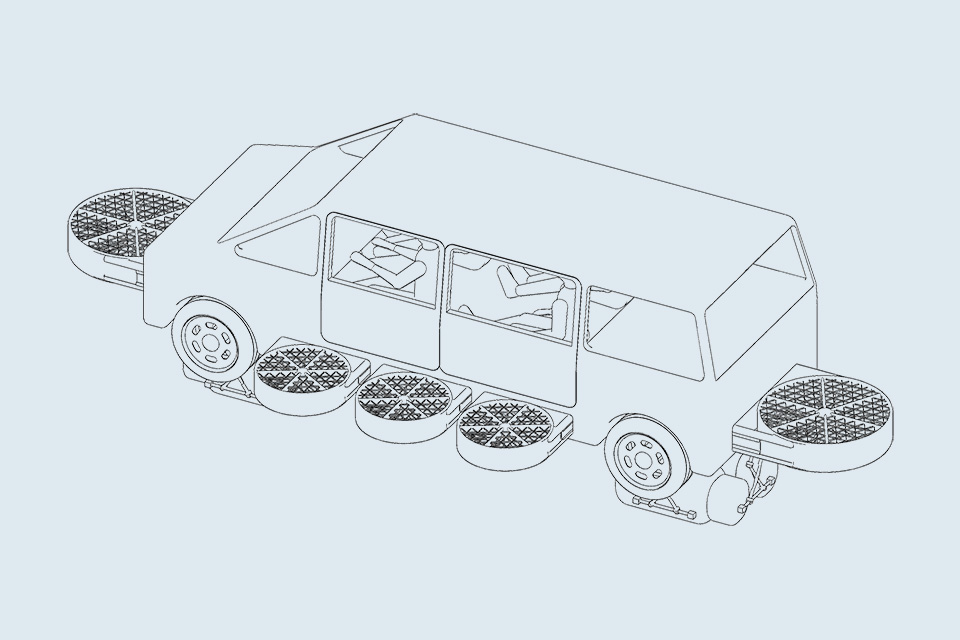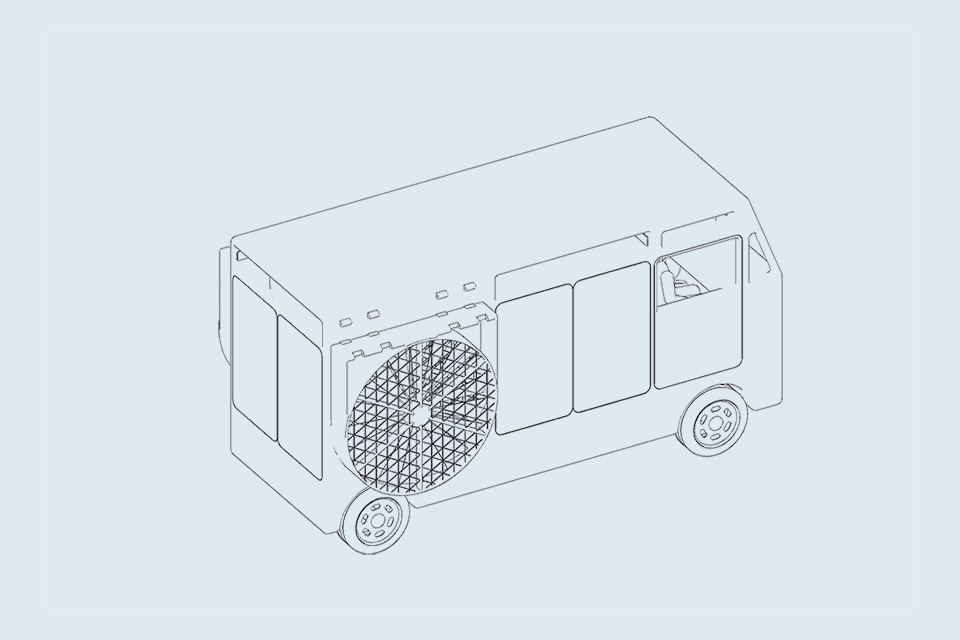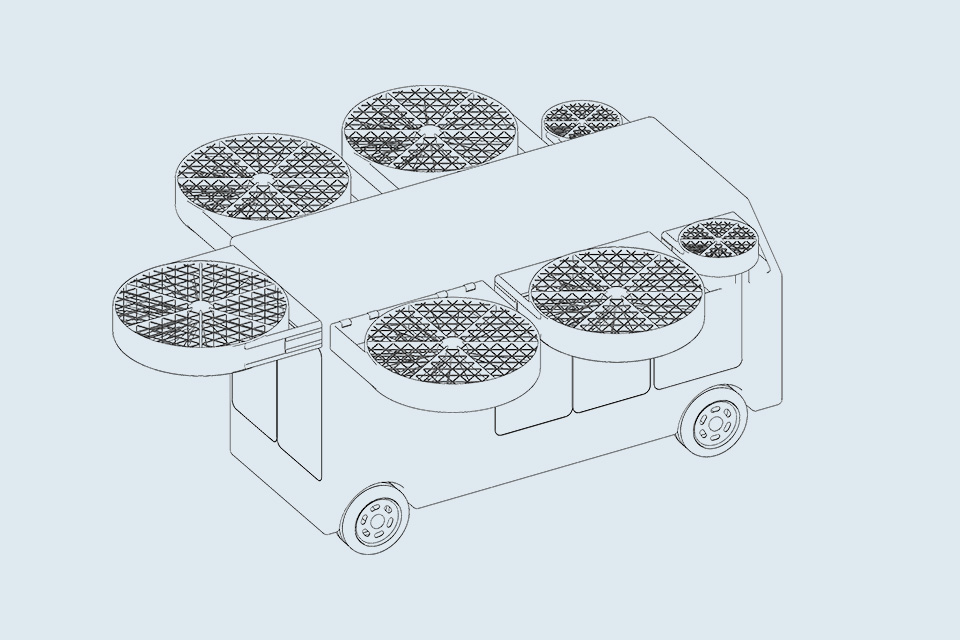Model Z
The Pegasos Zebra – our pegasious quad
Main Purpose
This model is our most innovative vehicle with the combined capability of travelling on land and in the air and for which both capabilities are equally given.
Due to it’s technical design – especially because of the spokeless and hubless wheels with integrated electrically driveable propellers (all propellers are driven independent of the wheels) as well as the related innovative suspension – the maneuverability of our Model Z however by far exceeds the maneuverability of most other existing vehicles, no matter if on land and/or in the air, i.e. it also exceeds the maneuverability of all our other models.
Because our Model Z is a quadcycle in land mode, it could simply be called a flying quad, but because it is a quadrocopter in aerial mode, it could also simply be called a driving quad. In order to use only one wording we therefore simply call it a pegasious quad, i.e. a quad with the combined capability of travelling on land and in the air.
The main purpose of this model is to fulfill the purposes of quadcycles and/or of quadrocopters, i.e. the purpose is to be a multi-purpose vehicle.
Our Model Z is therefore able to serve as an addition or alternative to cars or any other means of personal land vehicles (e.g. motorcycles), especially in situations in which travelling on land alone is not optimal, e.g. if road infrastructure is (often) overloaded, damaged/out of order, or if road infrastructure is not available at all. And it is also able to serve as an addition or alternative to helicopters or any forms of urban air vehicles which are not capable of travelling on land and which are therefore relatively unflexible in their handling on land.
Specific Characteristics
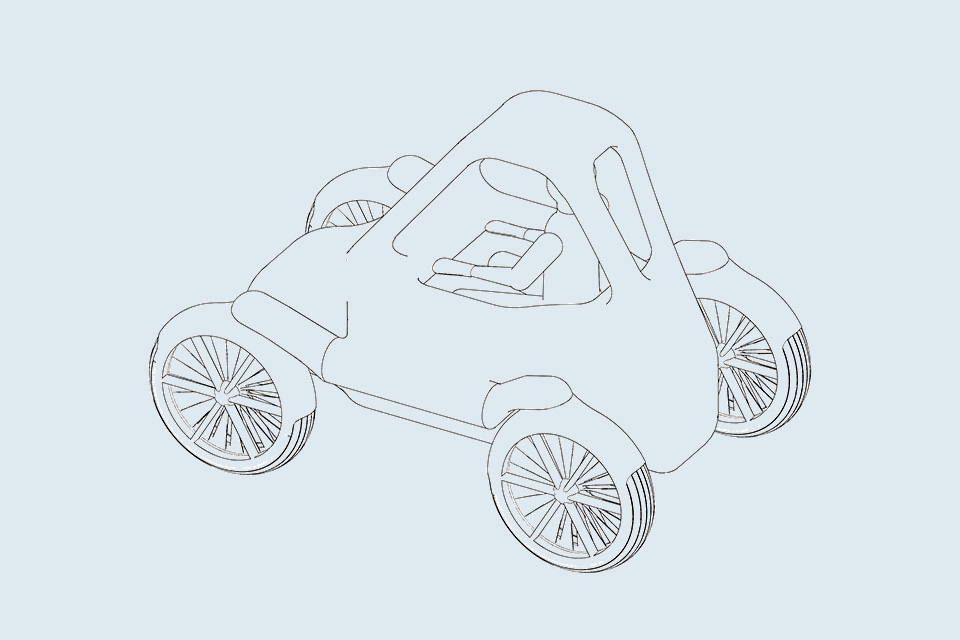
On land
In land mode all wheels with integrated electrically driveable propellers are in a position usual for land vehicles and the wheels are electrically driven.
In this state the vehicles width is similar to the width of cars and hence our Model Z is compatible with normal land vehicle infrastructure.
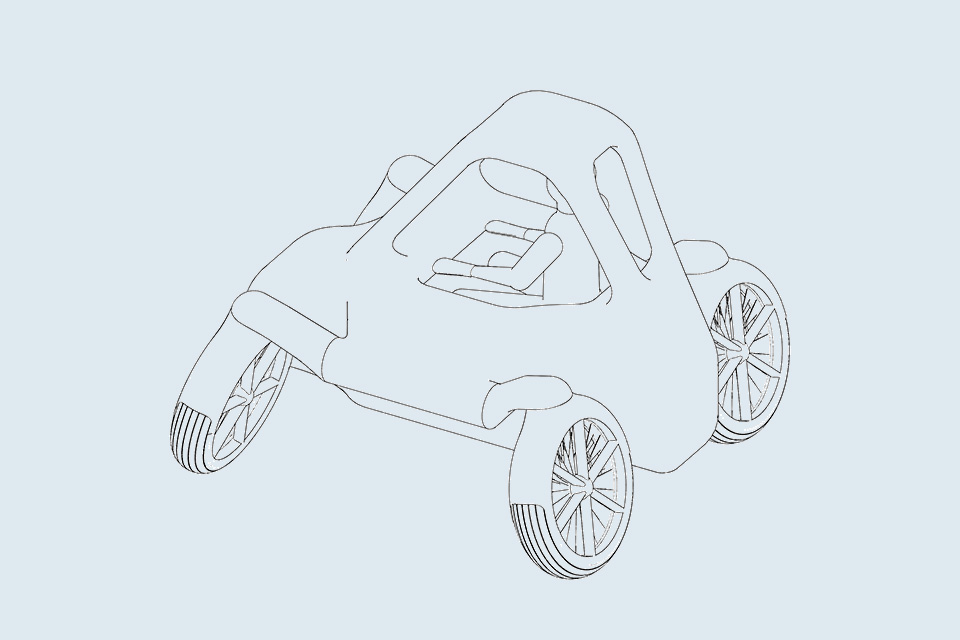
Transition (phase 1)
In phase 1 of the transition (land <-> air) all wheels with integrated electrically driveable propellers are turned to the position given in the picture by means of the innovative suspension.
In this state the vehicle’s width is wider than that of a car but it is still smaller than that of an usual street. This means that our Model Z is still compatible with normal land vehicle infrastructure and hence this transition can be carried out almost everywhere, e.g. in a normal parking space.
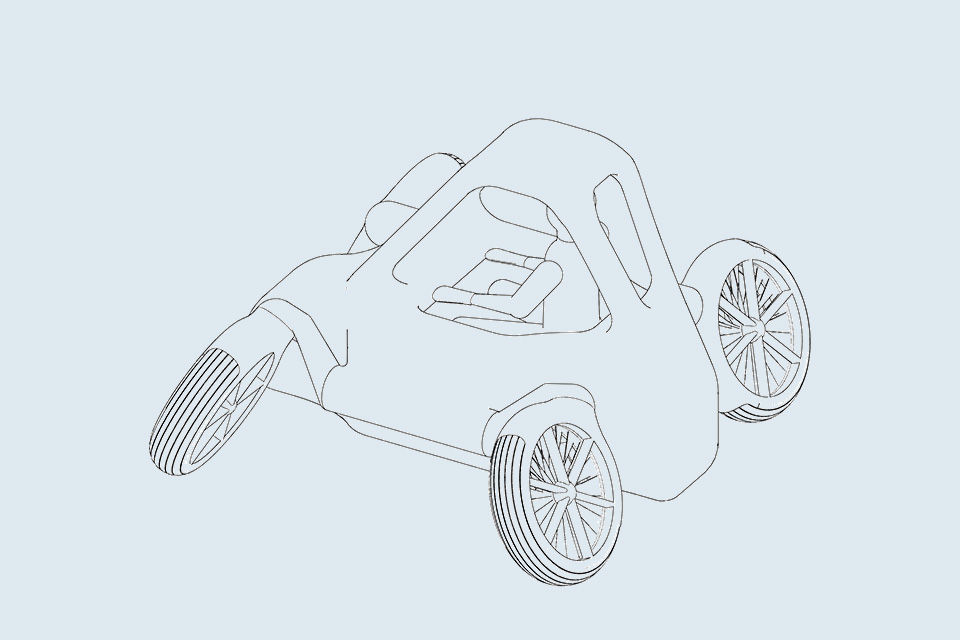
Transition (phase 2)
In phase 2 of the transition (land <-> air) all wheels with integrated electrically driveable propellers are lifted in relation to the rest of the vehicle by means of the innovative suspension. This means that the vehicle’s body is actually moving towards the ground until it touches the ground, like shown in the picture.
The wheels – but more relevant the integrated electrically driven propellers – however still continue to be lifted in relation to the rest of the vehicle, as so that they are now actually moving up in relation to the ground. This means that the propellers are then above ground and free to be positioned for flight.
Transition (phase 3) & in the air – vertical travelling
In phase 3 of the transition (land <-> air) all electrically driveable propellers (with their surrounding wheels) are turned into a position like the one given in the picture as so that the vehicle is ready for lifting off vertically.
In this state the vehicle’s width is still smaller than an usual street width and hence take-off and/or landing in principle is possible almost everywhere for our Model Z. This especially because in this position the tires are acting as bumpers and hence even contact between the vehicle and other objects will most likely not cause any damage.
The relatively heavy power source is located in the bottom of the vehicle and together with the lifted up propellers/wheels this results in a center of gravity of the vehicle which lays below the propeller plane, i.e. this results in a stable flight configuration.
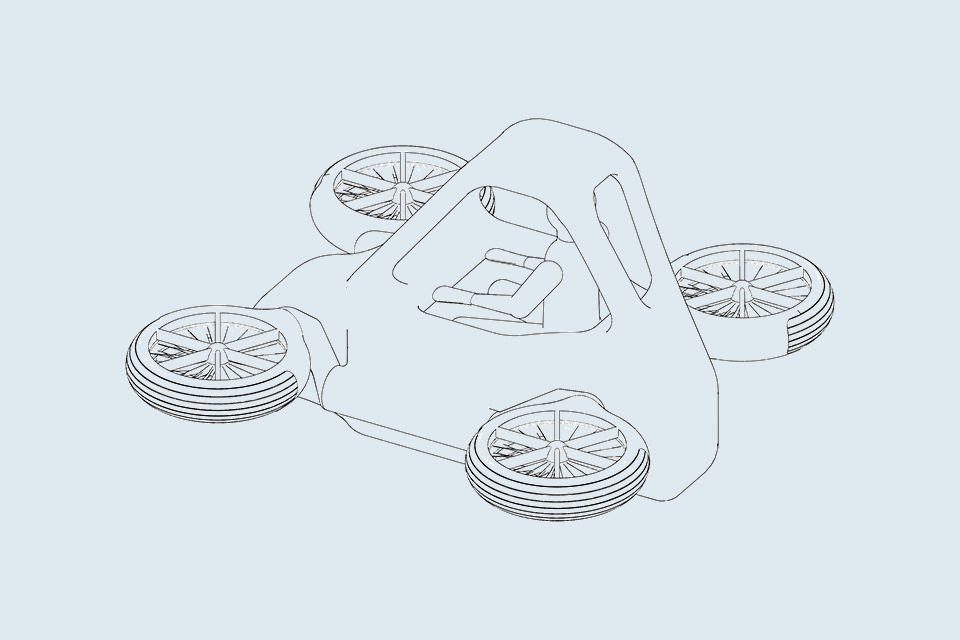
In the air – horizontal travelling
Due to the innovative suspension horizontal flight of our Model Z however can greately be enhanced by turning the propellers to some position optimized for horizontal travelling, e.g. for travelling straight ahead, like given in the picture.
Everything else from the previous section (wheels act as bumpers, center of gravity with resulting flight stability, as well as operation via Joystick/Touchpad) also applies in this flight mode.
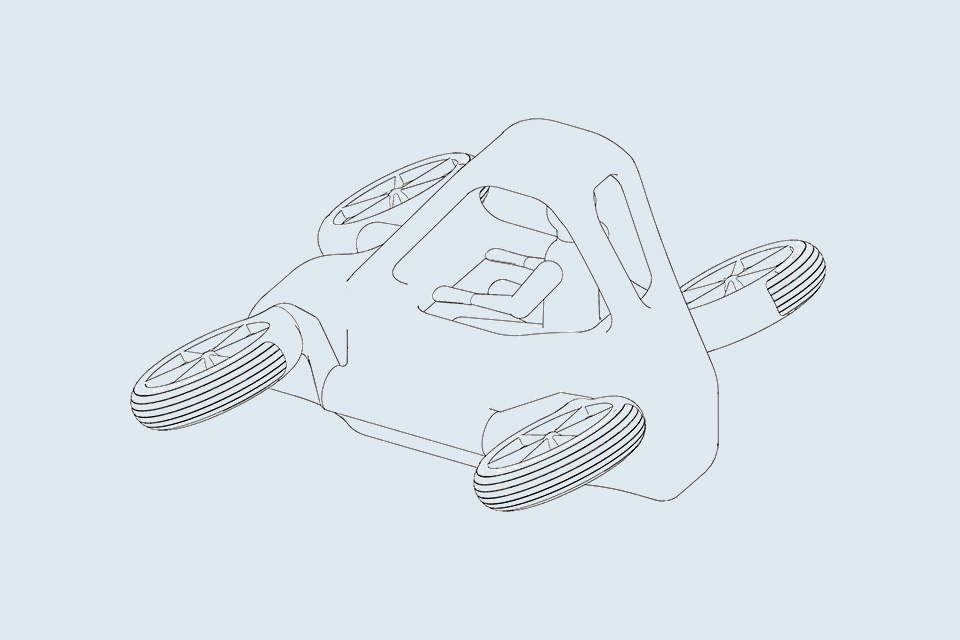
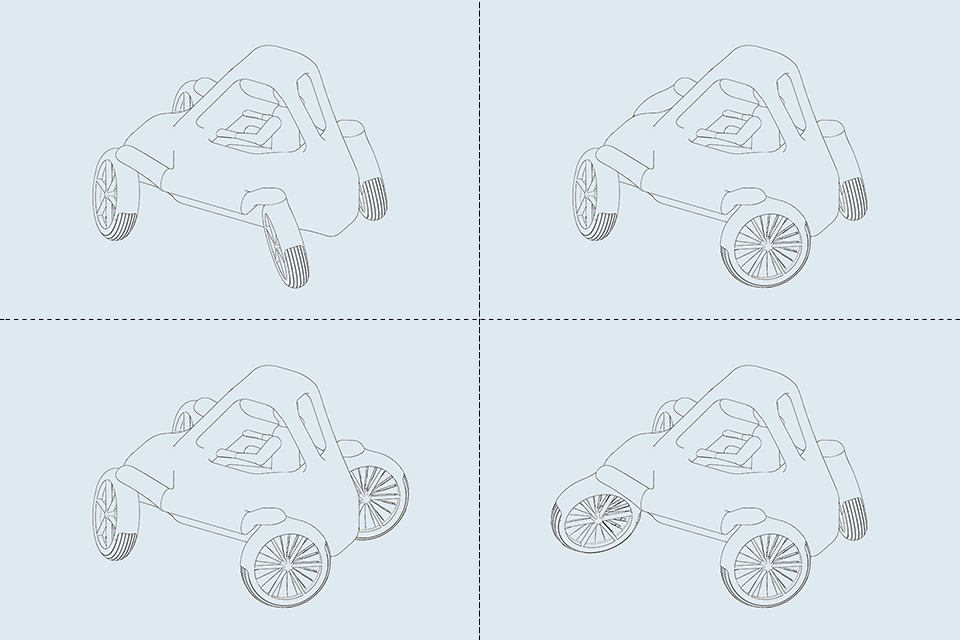
On land – special maneuvers
Due to the innovative suspension our Model Z is able to perform several maneuvers which are not possible with most land vehicles. These maneuvers are:
- Transversal (see phase 1 of the transition): Making parking simple.
- Diagonal (top left): With this maneuver it is possible to overtake other vehicles without having to change the looking directon.
- Turning on a point (top right): With this maneuver it is possible to completely turn the vehicle within the width of a street (i.e. within one lane).
- Bend around a point to the side of the vehicle (bottom left): This maneuver is like a normal bend but this vehicle is able to steer with all four wheels instead of the mostly usual two wheels, to the advantage of better cornering.
- Bend around a point in front/backwards of the vehicle (bottom right): With this maneuver it is possible to get around an object but with always having it straight in front/back.
- Bend around an arbitrary point (without picture): This is a combination of the previous two maneuvers.
In the air – optimized maneuvers
The horizontal aerial maneuvers of our Model Z – which are possible just alone by adapting the relative speed of the propellers – can be enhanced by adapting the propeller position by means of the innovative suspension. These maneuvers are:
- Straight ahead (see horizontal travelling) and backwards (analog)
- Transversal (top left)
- Diagonal (without picture): This is a combination of the previous two maneuvers.
- Turning around the vertical axis, resp. hovering (top right): Hovering with this propeller position is very stable, especially compared to helicopters.
- Bend around a point to the side of the vehicle (bottom left)
- Bend around a point in front/backwards of the vehicle (botttom right)
- Bend around an arbitrary point (without picture): This is a combination of the previous two maneuvers.
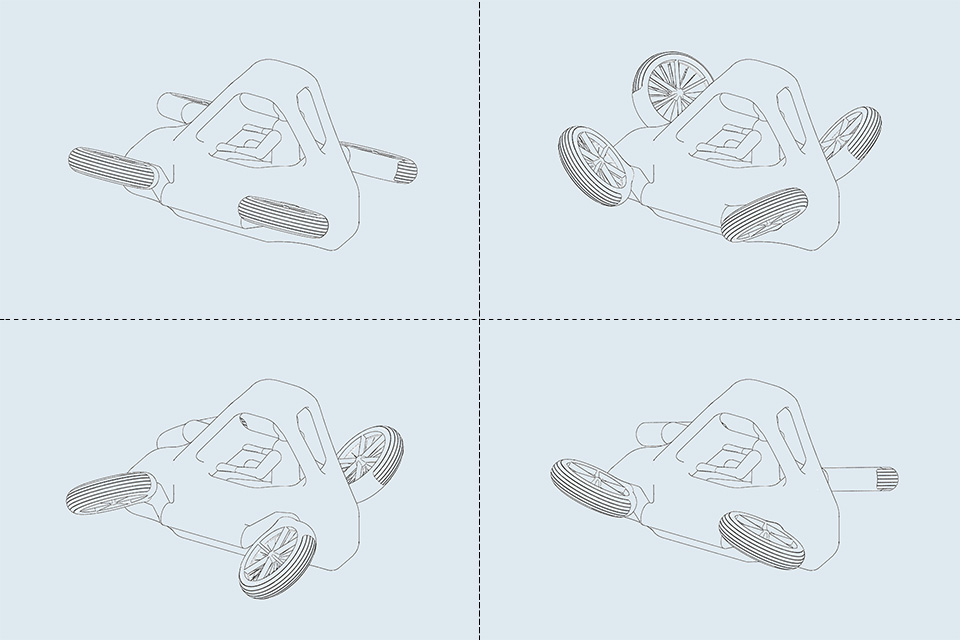
Specific Details
Seats
- 1
Transition between operation modes
- Automatic: in less than 1 minute
Power supply
- Internal combustion engine with standard gasoline for land vehicles
Controls
- Direct controlled by same controls (joysticks/touchpads) in all operation modes
Safety
- Redundant propellers
- Redundant power supply
- Stable flight by design
General
- Max. payload: ~200 kg
Land Mode
- Max. speed: ~150 km/h
- Max. operation range: ~800 km
Aerial Mode
- Max. speed: ~130 km/h
- Max. time in the air: ~60 minutes
General
- Weight: ~700 kg
- Fuell capacity: ~100 l
Land Mode
- Max. power: ~300 kW
- Max. length/width/height when driving
- forward/backward: ~2,5 m / ~1,6 m / ~1,7 m
- left/right: ~2,2 m / ~2,2 m / ~1,7 m
Aerial Mode
- Max. power: ~600 kW
- Max. length/width/height: ~2,5 m / ~2,4 m / ~1,5 m
Applications
With it’s specific characteristics and abilities our Model Z has many potential applications. A few of them are listed below.
For Individuals
- Recreational activities: Fun, Sport, Adventure, …
- Fast: short cuts, prevention of detours and of one way streets, direct connection (from airport to city center, city penthouse to shoppig mall, …), …
- Fleeing of: wildfire, fire in skyscrapers, flooding, paparazzi, …
- Continuing the journey: road infrastructure overloaded (traffic jams), damaged/out of order (landslides, avalanches, floodings, wildfires, collapsed bridges, …), not available (in remote regions), …
For Companies / Institutions
- Sports / Leisure Services: aerial sightseeing tours, vehicle rental, …
- Construction / Assembly: inspection & service (building sites, skiing lifts, roller coaster, giant ferries wheels, ships, oil platforms, …), …
- Media / Events: in front of the camera, advertisements, …
- Expeditions / Explorations: volcanos, glaciers, pollution (rivers, lakes, oceans, …), …
For Authorities / Emergency Services
- Search and Rescue: fast response (direct connection, short cuts, preventing detours and traffic jams, …), access if otherwise not possible (wildfires, fire in skyscrapers, mountain rescue, collapsed buildings, floodings, …), rescue from water (shark attack, strong current, …), …
- Police: fast (direct connection, short cuts, preventing detours and traffic jams, …), effective surveilance/monitoring (big events, special missions, …), …
- Border Patrol / Coast Guard / Customs: effective surveilance/monitoring (border, ship loads, …), …
For Military overcoming obstacles (gorges, collapsed bridges, water/islands, …), exploring, monitoring, surveilance, …
Orders/Pre-Orders






